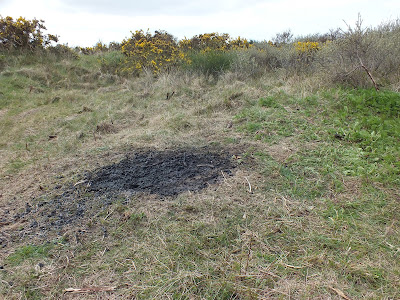What a busy few days, we have been joined by Simon Jones a Countryside Management student on a work placement module.
With another pair of willing hands quite a few jobs have been tackled, nothing onerous just jobs that needed doing.
With the school break in full swing, Monday found me dousing down a fire where guests had been making marshmallow smorfs? luckily the fire didn't spread into nearby Gorse, but the buggers had taken a wooden batten off the shelter, and off a nearby reptile refugia as fuel!!!.
Tuesday started with a briefing for Simon then a guided walk with Carmarthenshire Wildlife Walks, a total of twelve adults and two children in perfect weather.
The route enabled me to show off some early signs of spring in the shape of Green winged Orchid, Cowslip, Morels ( we found a few more and I continue to find them scattered widely), the beach held its usual array of shells and crab carapaces with examples of Velvet Swimming Crab and of course the curious looking Masked Crab. The best find of the morning though was the nationally scarce Dune Tiger Beetle.
I particularly like this group as they usually finish with a cup of tea and a cake.
 |
| Dune Tiger Beetle, a nationally scarce beetle. |
Simon and I then went and "painted" the inside of the shelter, it hadn't been painted before and its made a real difference. This was followed by some Education, Engagement and sadly some Enforcement, dogs, dog mess and another fire.
Wednesday saw the usual gang of VCR's out and at last those Dormouse boxes are in position at another reserve ready for occupation, the Pwll Lagoon and Ashpits LNR is another gem in Carmarthenshires crown of "wild" places.
 |
| At last, Dormouse box in situ, just need some residents to move in.. |
The afternoon gave us time to repair, yet again, a short stretch of grazing field fence at Pembrey.
Thursday, more work on the shelter, including some refreshed interpretation posters.
A full check of the now 10/11 reptile refugia revealed 11 Slow Worms and three Common Lizards. A female Garganey on one of the ponds was a good find, ( same pond as last autumns bird?). We rounded off the day with the creation of a couple of new ringing rides in the reed bed, but not before Simon witnessed the harder side of visitor engagement, when every breath is seemingly wasted on visitors who have "...been coming here for sixty years.. " (and I'll do what I want).
 |
Garganey, ♀
(I don't have any female pictures
of my own so I've borrowed this one,
key identification features are the head markings)
|



























